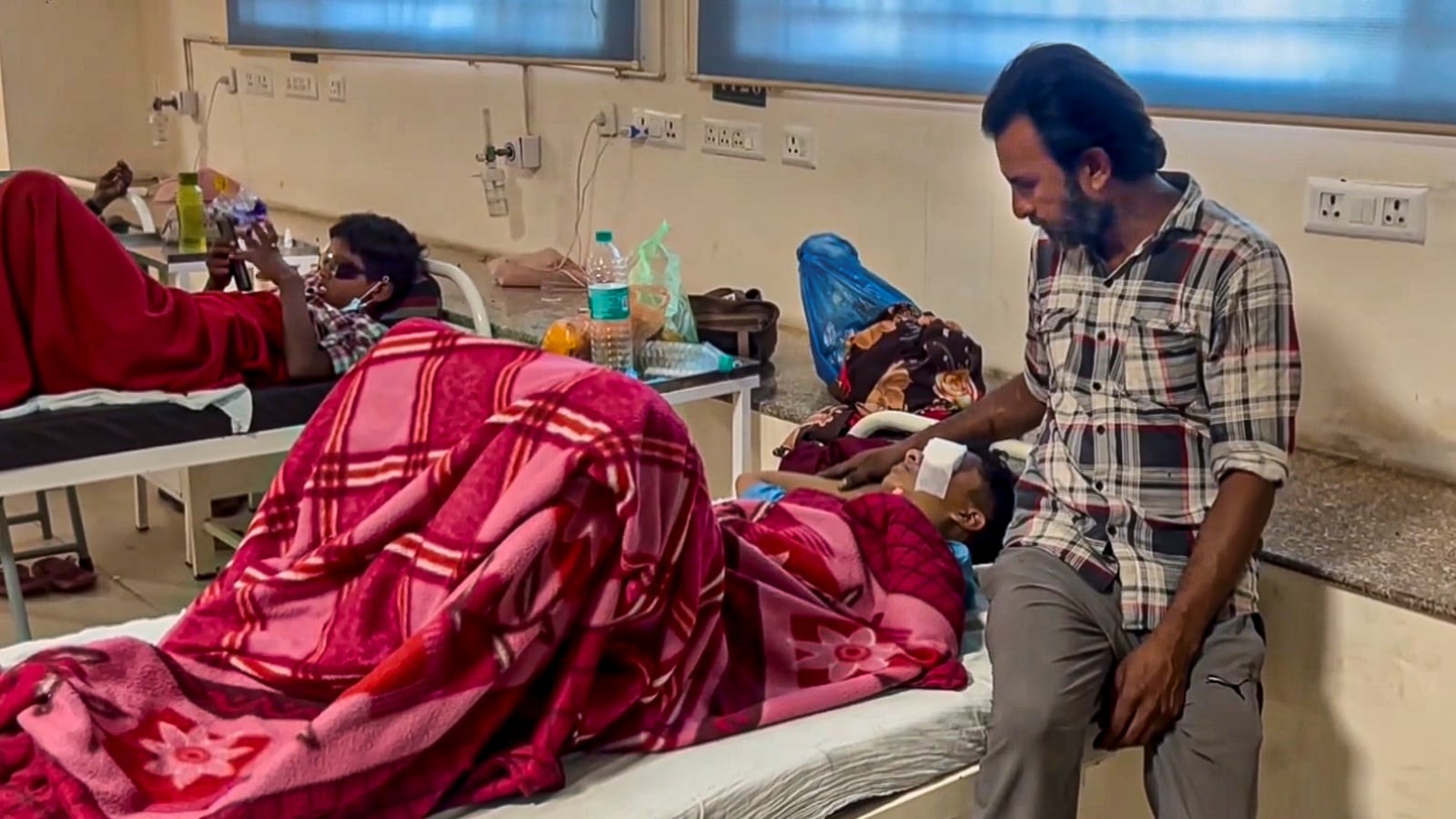More than 180 people, several of them children aged between 8 and 14, were hospitalised in Bhopal after suffering injuries caused by the use of “calcium carbide” guns during Diwali celebrations, as part of a viral social media trend that transformed the festive season into a public health crisis across Madhya Pradesh.
According to data provided by the Bhopal district hospital, a total of 186 persons sustained eye injuries in Diwali. Ten of them sustained permanent eye damage, 15 had to undergo surgery, 154 were referred to the OPD, and 32 to the in-patient department.
Chief Medical and Health Officer (CMHO) Dr Manish Sharma told The Indian Express: “There is no threat to their lives; some of the injured persons have sustained damage to their eyesight, while a few have suffered facial burns. In most cases, the children have sustained injuries to their cornea. After the sparks from the firecracker made contact with their cornea, inflammation was reported.”
 Injured people receive treatment at a hospital after a firecracker gun exploded during Diwali festival celebrations, in Bhopal, Wednesday, Oct. 22, 2025. (PTI Photo)
Injured people receive treatment at a hospital after a firecracker gun exploded during Diwali festival celebrations, in Bhopal, Wednesday, Oct. 22, 2025. (PTI Photo)
Dr Sooraj Singh Kubrey, Assistant Professor in the Department of Ophthalmology at Gandhi Medical College, Bhopal, said: “At Gandhi Medical College, we have four patients whose corneas are 90 per cent damaged, while 30 were discharged as they were brought in time for treatment. We anticipate that around 30 children would have sustained significant damage across Bhopal. The number will continue to rise in the coming days as more cases are reported from the peripheral areas of the capital.”
Health officials received the first case a day before Diwali, when a young boy sustained eye damage after he looked into the nozzle of the gun, which, officials said, is sold as a monkey repellent online. The main buyers used to be farmers who would occasionally sustain similar injuries. Last year, five patients suffered injuries while using the gun.
Dr Kubrey said his department was initially unaware of the device or how the injury exactly took place. “We had discussions with the ophthalmological society on WhatsApp groups, and then a ban was issued. We did not know about this gun. It is actually available in the market as a monkey repellent,” Dr Kubrey told The Indian Express.
On social media, hashtags like #CarbideGun had been trending since early October, with influencers and teenagers uploading reels demonstrating how to make and fire them at home. The reels had many users demonstrate building these guns from scratch using pipes, water bottles and devices resembling miniature rockets, as they mixed the chemical with water to demonstrate how it worked.
Story continues below this ad
On Diwali, patients streamed into the burn unit of the college with three types of injuries to their eyes. “The children had mechanical injury to the eye as they sustained high-velocity mechanical damage. Second, chemical injury because of the calcium carbide. And third, thermal injury from the heat of the explosion. We had been prepared for this to some extent. We had a fear of burn cases during Diwali, so the burn unit and the eye department had coordinated in advance. Maximum patients have come to us in a timely manner, but we are expecting more referrals from the periphery (of Bhopal). We worked till 2 am treating patients,” he said.
‘Looked into the barrel, it exploded’
Outside the ophthalmology ward at Gandhi Medical College, Reshma clutched her son’s discharge slip, her hands trembling. Her 10-year-old, Alzain, had been playing with what she thought was a harmless Diwali toy purchased for Rs 100 at a local fireworks market.
“It stopped working after a few rounds,” she said, her voice barely audible. “Alzain looked into the barrel, and it suddenly exploded. Blood poured from his eye.”
Doctors told her that carbide fragments had penetrated deep inside.
Story continues below this ad
Down the same hospital corridor, Prashant from old Bhopal lay with bandages covering both eyes. Surgeons had removed carbide shrapnel embedded in his corneas, but the damage was severe. “Now I can see only a white blur,” he said. “They don’t know if I’ll ever see clearly again.”
Neha, another patient at Hamidia hospital, had assembled the firecracker at home. When her homemade device failed to fire, she looked down the barrel to troubleshoot. “The gun went off in my face. The cracker exploded in my eye,” she said. Doctors assured her she would recover, but warned her vision would not be the same.
Twenty-two-year-old Satendra had a similar experience: “When it didn’t go off, I brought it close to my face to check the water. That’s when it exploded. The barrel burst apart. I just want my eyesight to be normal again.”
The youngest victim treated at Sudarshan Netralaya was a 10-year-old boy whose gun misfired. He peered through the nozzle — and his entire left eye was obliterated in the blast. Another young patient had already lost one eye in a previous accident. The carbide gun injured his healthy eye.
Story continues below this ad
Dr Prateek Gurjar, who performs surgeries at Sudarshan Netralaya, has treated over 30 patients in just three days. The injuries range from thermal burns to chemical corrosion of the cornea.
“These are not new inventions,” Dr Gurjar explained. “They are old guns which farmers used to scare away wild animals. We used to treat farmers. But this time, people are using them as Diwali crackers. We’ve seen patients from ages 10 to 25.”
Initial treatment costs Rs 8,000 to Rs 10,000, but full vision restoration, when possible, can run into several lakhs, health officials said.
Authorities have launched coordinated crackdowns across the state. In Vidisha district, police arrested six people for illegally selling the devices.
Story continues below this ad
In Berasia, the administration seized 19 guns this week. But enforcement faces formidable obstacles. The guns sell for as little as Rs 100, and street vendors who operate in informal markets are difficult to monitor. Crucially, many victims made the devices at home using freely available tutorials, Bhopal district administration officials said.
Sources in the MP police said the local authorities were “caught unaware by the popularity of the guns, which skyrocketed on social media in October”. A senior police officer tasked with cracking down on the crude devices explained, “These are simple to make with the help of metal pipes and plastic bottles; others bought ready-made versions from roadside stalls. A plastic or tin pipe is filled with calcium carbide. When water is added to the calcium carbide, it produces acetylene gas, and when ignited, the gas detonates with tremendous heat and force.”




